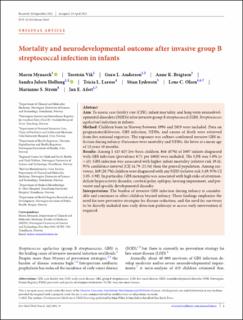| dc.contributor.author | Mynarek, Maren | |
| dc.contributor.author | Vik, Torstein | |
| dc.contributor.author | Andersen, Guro Lillemoen | |
| dc.contributor.author | Brigtsen, Anne Karin | |
| dc.contributor.author | Hollung, Sandra Julsen | |
| dc.contributor.author | Larose, Tricia L | |
| dc.contributor.author | Lydersen, Stian | |
| dc.contributor.author | Olsen, Lene Christin | |
| dc.contributor.author | Strøm, Marianne | |
| dc.contributor.author | Afset, Jan Egil | |
| dc.date.accessioned | 2023-07-24T08:45:30Z | |
| dc.date.available | 2023-07-24T08:45:30Z | |
| dc.date.created | 2023-06-12T14:31:44Z | |
| dc.date.issued | 2023 | |
| dc.identifier.issn | 0012-1622 | |
| dc.identifier.uri | https://hdl.handle.net/11250/3081045 | |
| dc.description.abstract | Aim: To assess case fatality rate (CFR), infant mortality, and long-term neurodevelopmental disorders (NDDs) after invasive group B streptococcal (GBS; Streptococcus agalactiae) infection in infants. Method: Children born in Norway between 1996 and 2019 were included. Data on pregnancies/deliveries, GBS infection, NDDs, and causes of death were retrieved from five national registries. The exposure was culture-confirmed invasive GBS infection during infancy. Outcomes were mortality and NDDs, the latter at a mean age of 12 years 10 months. Results: Among 1 415 625 live-born children, 866 (87%) of 1007 infants diagnosed with GBS infection (prevalence 0.71 per 1000) were included. The CFR was 5.0% (n = 43). GBS infection was associated with higher infant mortality (relative risk 19.41; 95% confidence interval [CI] 14.79–25.36) than the general population. Among survivors, 169 (20.7%) children were diagnosed with any NDD (relative risk 3.49; 95% CI 3.05–3.98). In particular, GBS meningitis was associated with high risks of attention-deficit/hyperactivity disorder, cerebral palsy, epilepsy, hearing impairment, and pervasive and specific developmental disorder. Interpretation: The burden of invasive GBS infection during infancy is considerable and continues to affect children beyond infancy. These findings emphasize the need for new preventive strategies for disease reduction, and the need for survivors to be directly included into early detection pathways to access early intervention if required. | en_US |
| dc.description.abstract | Mortality and neurodevelopmental outcome after invasive group B streptococcal infection in infants | en_US |
| dc.language.iso | eng | en_US |
| dc.publisher | Wiley | en_US |
| dc.relation.uri | https://onlinelibrary.wiley.com/doi/full/10.1111/dmcn.15643 | |
| dc.rights | Attribution-NonCommercial-NoDerivatives 4.0 Internasjonal | * |
| dc.rights.uri | http://creativecommons.org/licenses/by-nc-nd/4.0/deed.no | * |
| dc.title | Mortality and neurodevelopmental outcome after invasive group B streptococcal infection in infants | en_US |
| dc.title.alternative | Mortality and neurodevelopmental outcome after invasive group B streptococcal infection in infants | en_US |
| dc.type | Peer reviewed | en_US |
| dc.type | Journal article | en_US |
| dc.description.version | publishedVersion | en_US |
| dc.source.journal | Developmental Medicine & Child Neurology | en_US |
| dc.identifier.doi | 10.1111/dmcn.15643 | |
| dc.identifier.cristin | 2153846 | |
| cristin.ispublished | true | |
| cristin.fulltext | original | |
| cristin.qualitycode | 1 | |

